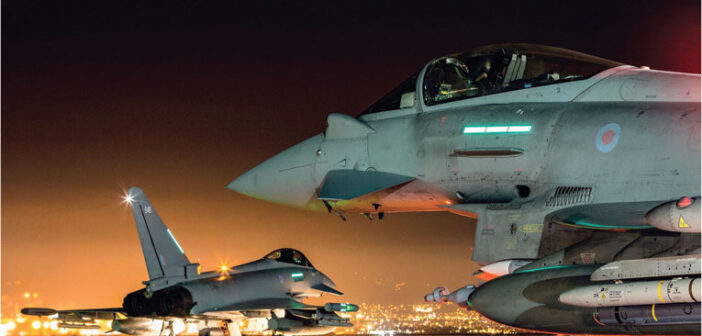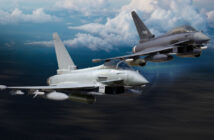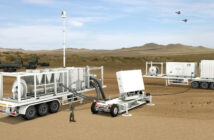
Originally conceived as a Cold War air defender, the four-nation Eurofighter Typhoon fighter has over time evolved into an advanced swing-role combat aircraft providing simultaneously deployable air-to-air and air-to-surface capabilities. In addition to its “parent” customers – Germany, Italy, Spain and the UK – variants of Typhoon also serve with the air forces of Austria, Oman and Saudi Arabia, and are on order for Kuwait and Qatar.
The aircraft has won its spurs in combat missions over Libya, Iraq and Syria, and has also regularly contributed to NATO’s Baltic Air Policing mission. Furthermore, Eurofighter Jagdflugzeug GmbH – the industrial consortium of Airbus, BAE Systems and Leonardo responsible for the design, production and sustainment of Typhoon – is continuing to pursue new business: for example, Typhoon is one of a number of candidates for Finland’s HX fighter acquisition program, while Germany has signaled its intention to order up to 93 more aircraft to meet its respective Project Quadriga and Tornado replacement requirements.
With the expectation that Typhoons will remain flying out beyond 2050, the Eurofighter industry partners and the NATO Eurofighter & Tornado Management Agency (NETMA) have now begun to explore options for enhancement and sustainment the under the umbrella of a multi-strand Long Term Evolution (LTE) activity. One of those strands is specifically examining the way forward for the aircraft’s Praetorian Defensive Aids Sub System (DASS).
At the same time, the Euro-DASS consortium – made up by Leonardo, Elettronica, Indra and Hensoldt – is self-investing in the definition and maturation of an evolved DASS architecture known as Praetorian eVolution (eVo) that seeks to assure the electronic warfare (EW) and platform self-protection capability of Typhoon against an evolving threat out to the type’s Out of Service Date (OSD).
DASS ORIGINS
The mission programmable Praetorian DASS suite fitted to the Typhoon is an intrinsic part of the aircraft’s advanced multi-role capability, providing the aircraft with self-protection against air-to-air and surface-to-air threats. BAE Systems, on behalf of the four-nation Eurofighter consortium, has taken the role of Equipment Design Responsible for the provision and installed performance of the full DASS fit. This embraces the totality of Praetorian (based on integrated electronic support measures and electronic countermeasures [ESM/ECM] equipment against RF emitters and an active missile warner system to provide alert of missile threats), two underwing Saab BOL-510 integrated chaff dispensers (housed in the weapon pylons), and Cobham-supplied integrated flare dispensers housed in the actuator fairings beneath the wings.
As the central component of the DASS, Praetorian itself comprises approximately 20 Line Replaceable Items (LRIs) and Shop Replaceable Items (SRIs). The power supply, ESM/ECM processor, techniques generator and RF source are all located in the Typhoon’s internal avionics bay, as are the processor and transmitter boxes associated with the missile warner.

Each wingtip pod hosts eight ESM receive antennas, plus associated preselector and downconverter LRIs. The port wingtip pod also contains solid-state ECM phased array transmitters fore and aft, together with a monopulse steering unit.
The aft section of the starboard wingtip pod houses two Towed Radar Decoy (TRD) dispensers, each containing a flight body, tow cable, and deployment and braking mechanism. A TRD is deployed using a 100-meter Kevlar cable containing a fiber-optic link and a separate Extra High Tension power distribution line.
Space and weight provisions remain in the forward section of the pod for an additional ECM phased array transmitter. Also housed in the starboard wingtip pod is the power supply unit for the TRD installation.
Heat management in the wingtip pods – essential to allow the equipment LRIs to be shrunk down – presented a significant development engineering challenge. Engineering studies showed that none of Polyalphaolefin, Coolanol, R25, water or water glycol could cool below the cold wall temperature limit of 70°C. The answer, neatly embodied in each pod, is an elegant yet robust liquid-to-vapor phase compression system using R245fa liquid refrigerant.
The missile warner features an aft-facing antenna for rearward coverage, and two forward-facing antennas in the wing roots to cover frontal aspects port and starboard. Given the very high closing speeds on the frontal aspect, low-noise amplifiers are matched to the two wing root antennas so as to offer enhanced sensitivity.
Overall DASS system control is exercised through the dedicated and fully reprogrammable Defensive Aids Computer (DAC). The DAC interfaces, via the defensive aids bus, with all DASS subsystems and, through a STANAG 3910 fiber-optic data-bus, into the Typhoon avionics system. The functionality residing in the DAC provides a fully automated capability to analyze and respond to multiple threats, ensuring sensor interoperability at platform level, prioritizing and coordinating the appropriate countermeasures response, and authorizing specific jamming techniques.
Typhoon pilots can access DASS information by means of a specific “page” shown on any one of three heads-down Multifunction Head Down Display units. Cues can also be shown on the pilot’s wide-angle Head Up Display.
As well as providing self-protection by means of automatic threat alert and responsive countermeasures, the Praetorian DASS is an important contributor to Typhoon’s fused sensor picture. That reflects both the sensitivity and measurement accuracy of the ESM subsystem, and commensurate investment in programmable mission data to maximize the efficacy of the DASS in specific theatres and scenarios.

The UK is unique among the four Eurofighter partners in that it also procured a laser warner system for its Typhoons as a national fit (hence outside the boundary of the Praetorian DASS). Developed by Leonardo in Edinburgh, this instantiation of the company’s Type 491 laser warner features six passive sensor heads, distributed around the airframe, connected via fiber-optic cables to a central processor unit.
Praetorian has already been upgraded during Typhoon’s lifetime. Tranche 1 aircraft gestated in an era when highly proscriptive Mil-Spec standards were the norm, which conditioned the use of highly bespoke processors and interfaces.
However, pricing development for Tranche 2 aircraft highlighted the fact that the Praetorian DASS electronics architecture would require significant re-engineering in order to resolve hardware obsolescence and ensure sustainability. Furthermore, the insertion of new software-based functionality would require new high-speed processors able to execute more complex algorithmic functions.
As a consequence, the aircraft in Tranche 2 and after have seen a widespread transition to commercial-off-the-shelf (COTS) hardware, with software re-hosted on a new processing architecture based on PowerPC processor cards. Harnessing COTS innovation has also enabled reductions in size, weight and power requirements, while at the same time providing a platform for expanded functionality. A Common Obsolescence Removal Program was established in parallel to ensure that the Praetorian baseline remains in step with the accelerated cycle time of the COTS component market.
Praetorian at Tranche 2 build standard has also introduced new functionality. For example, dual-circular polarized ESM antennas and improved Digital Radio Frequency Memory (DRFM) and TRD equipment have all been embodied.
However, there is no escaping the fact that the existing Praetorian DASS was defined in the late 1980s/early 1990s. As a consequence, its architecture now imposes constraints on further development with regard to further expansion, capability insertion, and long-term sustainability.
LTE STUDY
There is a consensus across both the Eurofighter industry team and the Typhoon customer community that now is the time to look at options to further evolve the aircraft and its weapons system so as to ensure continued relevance out to 2050. To address this need, Eurofighter Jagdflugzeug GmbH, EUROJET Turbo GmbH and NETMA in May last year signed initial contracts worth an aggregate €53.7 million to support a series of LTE studies aimed at identifying technology enhancements in areas of mission system architecture, human-machine interface, DASS, power and cooling, and engine performance.
These study contracts are designed to provide a clear road map for the longterm development of the aircraft against a backdrop of accelerating technology advancement and growing threat proliferation. From the standpoint of the DASS, the objective of the LTE is to explore potential future requirements out to 2060 in order to enable Typhoon to maintain an edge against these new threats.
Under an 18-month contract awarded by BAE Systems (on behalf of Eurofighter Jagdflugzeug GmbH), the EuroDASS consortium has been tasked to characterize the future threat environment, evaluate potential future DASS requirements, identify technologies and techniques to enhance the survivability of Typhoon, and deliver options for long-term technical solutions and enablers which will sustain the growth path of the platform in the future. “Each of the four industry partners is addressing specific topics within the study,” Phil Liddiard, Leonardo’s vice president combat air, explained. “We started with an analysis of where we thought the threat would be [going]over the next 30 years, identified the capability gaps, and then came up with options to fill those gaps. The work has looked at how we keep the current [Praetorian DASS] system flying and manage obsolescence removal. At the same time, we have looked at future technology options in light of likely threat trends.”
Among the options are a more flexible software-driven architecture, allowing for the introduction of new capabilities in a more agile and low-cost manner. Improvements to the exploitation and fusion of onboard sensors are also being investigated, and work is additionally considering both onboard and offboard countermeasures.
EuroDASS in February 2020 submitted its interim report, including a range of options, to BAE Systems, which has in turn passed the conclusions to NETMA. The plan as it stands – pending the full impact of COVID-19 – is that NETMA will downselect specific options and issue a Request for Quotations (RFQ), with EuroDASS to respond with a bid by the end of 2020.
“We have a baseline option, which is basically taking the current system forward,” said Liddiard. “Then we have two additional options, based on a new architecture, one left of arc and one right of arc. So as you go left to right so we cover more and more of the gaps.
“Obviously, from an affordability view, the cost increases the further you go to the right. That is also true on the impact to the airframe and the aircraft. We can’t do these modifications without BAE and the other EPCs [Eurofighter Partner Companies]. At the end of the day this will be a joint activity.”
Option 1 seeks to maximize the capability of the existing fleet, proposing modifications that would keep a limited level of growth going forward. For future aircraft, EuroDASS has, in options 2 and 3, proposed a new architecture to enable continued growth out to OSD. “If you’re building a new aircraft you have more scope for changing some of the pods, and the wiring and cooling situation,” explained Liddiard. “And if you want to exploit the improved reliability, then we need to start removing some of the microwave analog circuitry that’s [currently]in there.
“We are not saying that options 2 and 3 are unsuitable for retrofit to existing aircraft,” he added. “But they would be quite disruptive retrofits that would likely require a return-to-works program, because the implications for the airframe are more significant.”
Liddiard continued: “Option 1 is basically replacing current units with new hardware that would fit in the same spaces with minor wiring changes, some of which have already been proposed and incorporated into later Tranche 2 and Tranche 3 aircraft. So, it can be performed by updates to the current architecture and is less invasive to the aircraft, and builds on existing national programs.”
However, it is acknowledged that Option 1 will not offer the same capability “headroom” for growth as the new architecture. One of the key limiters, for example, would be the number of digital channels. “Yes, it will have digital channels, but they won’t necessarily be able to be used all over the bandwidth at the same time,” explained Liddiard. “With options 2 and 3, then that would be a full digital architecture with modular software supporting algorithmic mission data applications that we’ve been developing, software-configurable common hardware modules, and multi-platform cooperative techniques.
“For the end user, it brings benefits in terms of improved situational awareness against modern and complex threats, improved threat ID, a greater contribution to the overall weapon system, and the ability to have agile updates – even on the fly potentially, if the comms are in place on the aircraft. It will also give improved reliability, so less spares leading to lower costs of ownership and increased availability.”
The intention is, Liddiard added, that baselining the Option 2 configuration would still enable phased growth to the full Option 3 standard in due course. “So, for instance, you could plug in additional digital modules for more channels over time. That could be a way that the nations end up with slightly different systems, but it will all be within the same architecture concept.”
EVOLUTION THEORY
This “optioneering” work has been based on internal activity started by EuroDASS prior to the start of the LTE study activity. “This is what we’re calling Praetorian eVolution, or Praetorian eVo for short,” said Liddiard. “As a consortium, we’ve been looking at various solutions over the last three years or so [because]we recognized the need some time ago to get a head-start on working up what we thought was the best option. We’re covering all the elements of the current system, so that’s the ESM, the ECM – onboard and offboard – and the missile warner.”
Investment to date – measured in several millions of Euros – has been funded by the EuroDASS board and the partner companies. The teams involved with Praetorian eVo and LTE are essentially the same personnel to maximize the transfer of eVo thinking into the LTE contract.
“We started out examining what we thought the partner nations would want going forward, and how the future threat was evolving,” said Liddiard. “We then looked at the technology available, and have developed an architecture to keep the Typhoon DASS/EW system relevant through to out-of-service-date in the middle of the century.”
At an operational level, work to evolve a future DASS architecture is addressing the fast evolving and ever more complex threat environment. In turn, this is driving expansion beyond the classic self-protection role such that EW can make a greater contribution to Typhoon situational awareness, and combat ISR functions such as high-precision targeting and advanced combat identification. Multi-platform EW is also on the agenda.
Praetorian eVo was first briefed to NETMA at a conference in October 2019. The roadmap laid down by Euro-DASS envisages the move to an all-digital architecture so as to simplify future upgrades, optimize lifecycle costs, and make the best use of mission data. “This will improve adaptability, and improve the speed of updates by enabling software-based spiral development to keep ahead of the threat,” Liddiard said. “It also provides an opportunity to take advantage of the latest hardware advances to increase the reliability and reduced integrated logistics support requirements.”

He continued: “The baseline architecture will be common across the nations, so that each partner has a minimum standard and can then develop additional national capabilities as required. That’s why we’ve gone for the algorithmic software concept so you can ‘bolt on’ software modules.
“What we are very keen to avoid is any substantial deviation in the baseline. Keeping multiple configurations of build standards is already hard.”
Praetorian Evolution is architected around common modules. “We would move away from specific, dedicated analog circuits, and move to an architecture based on common digitized modules with firmware and software dictating the function,” Liddiard said. “That gives you much more flexibility in how you use resources across the entire system.”
This approach also supports a DASS solution that is supportable, sustainable and cost-efficient. “Improved availability, reliability and maintainability is another key driver for the new architecture,” Liddiard observed. “In the past, [we had]dedicated microwave functions where each one was a completely independent module that had to be tested right across the temperature band. That incurs significant costs in terms of making sure that it all works. The idea with the new system is that an awful lot of that functionality will be digitized immediately, and that work will now be performed on what are effectively common hardware modules using software functions.”
Much of the thinking around mission data and apps has been based on trials work already performed by Leonardo in the UK to evaluate the way that adversaries are changing the nature of the threat. For example, introducing modern processing to older generation radars to enable them to produce new waveforms
“We’ve been developing mission data for many years,” Liddiard pointed out. “Previously, it was sufficient to identify emitters on the basis of descriptors, such as frequency and PRF. But as things get more and more complex, we actually need algorithms to recognize the waveforms, and you can then try and determine the mode of the threat. Knowing what mode the threat is in means you can decide whether it is necessary to alert the pilot. Previously, you had to identify the threat as soon as you saw it. Now we want to bring more intelligence into the system to support the pilot.”
DASS integration within the Typhoon airframe and wider weapons system is an important consideration. “BAE is looking at new displays and buses, and Euro-DASS wants to maximize their potential in the new architecture,” said Liddiard. “So, the DASS solution must fit within the constraints of space, weight power and cooling.”
One item outside of the Praetorian eVo scope is the application of Typhoon’s new Captor-E active-electronically scanned array (AESA) multi-mode radar to the electronic attack mission. The UK’s Bright Adder technology demonstrator program has sought to demonstrate “jamming through the radar,” and the Royal Air Force has ambitions to incorporate this functionality in its so-called Radar 2 build standard. In this case, it would be necessary to engineer a high level of functional interoperability between the DASS and the AESA radar.”
TECHNOLOGY HORIZONS
Some technology developments – partly customer-funded – are already underway to mature certain key technologies. For example, EuroDASS recently demonstrated digital receiver algorithms installed in the current processor standard. There is also an expectation that Leonardo’s BriteCloud expendable active decoy technology – development of which has been supported by the UK customer – will be exploited.
Another proposal within Praetorian eVo is the introduction of a hybrid active/passive [radar/IR) missile warner. “The real estate currently occupied by the laser warners [on UK aircraft]is something we’re coveting for the hybrid warner, as we would need a few extra sites for sensor heads,” Liddiard said. “That would build on the real estate that the current active missile warner occupies. Subject to the customer requirement, we believe the hybrid missile warner would have benefits and should significantly reduce false alarms.”

The application of cognitive EW techniques – using Machine Learning to aid detection, characterization and jamming against previously unknown threat waveforms – is also being explored. “What we’re conscious of is that we can’t have a full software clearance process every time that we change a bit of that sort of software because, by definition, it’s going to be pretty rapid development,” explained Liddiard. “Part of the reason for having the apps and the algorithmic mission data is having the ability to be able to put that sort of [functionality]in [the DASS]– making sure it doesn’t degrade the baseline system – and then enable it as additional advice [to the pilot].”
Going forward, EuroDASS currently expects some “order cover” in the first or second quarter of 2021, although whether that is a full-scale development program or a more modest level of start-up/long lead activity has yet to be determined. “This [program]clearly represents a significant investment, and there will almost certainly be some trade-offs,” said Liddiard. “So, it could be that there will be some further work to do before the final configuration is settled on.”
The timescale for implementation of a modernized DASS remains dependent upon the LTE contract, and how the Eurofighter partner nations decide to progress: at this stage, initial indications are for the realization of the LTE around the mid-2020s, leading to aircraft deliveries in the late 2020s/early 2030s. What is already clear is that the modernization of the Praetorian DASS will be a critically important program for both Typhoon operators, and a number of the main industry players in the European EW sector.






